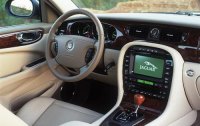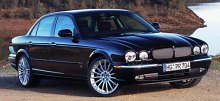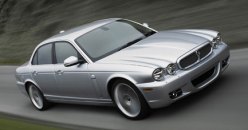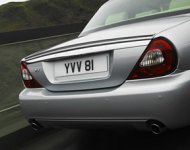|
Jaguar XJ
Debut: 2003
Maker: Jaguar
Predecessor: XJ8 (1997)
|
|
 The
new generation Jaguar XJ is full of surprise. Firstly, its styling
changed
little from the original XJ, which was born in 1968. Secondly, behind
the
classical appearance is a radical aluminum chassis and bags of advanced
technologies. Thirdly, it provides interior room matching the roomiest
cars in class. Surprise? The
new generation Jaguar XJ is full of surprise. Firstly, its styling
changed
little from the original XJ, which was born in 1968. Secondly, behind
the
classical appearance is a radical aluminum chassis and bags of advanced
technologies. Thirdly, it provides interior room matching the roomiest
cars in class. Surprise?
Those
who criticized the new XJ looking too close to the old car must be mad.
Why bother to change the look if the original was so beautiful? The
original
XJ6 was styled by one of the world's best designers ever (William
Lyons,
or Jaguar's founder) and was seen as a design classic. Time does not
change
our taste of beauty. A beautiful car is always a beautiful car no
matter
how many years have passed. Throwing tradition away in the pursuit of
changes
- like what BMW's Chris Bangle is doing - does not make sense to
Jaguar.
Jewel of the crown needs just polishing.
So,
what you see here is the most classical-looking luxurious car in the
world
currently on offer. Penned by the late Geoff Lawson before he died and
finished by his successor Ian Callum, the new XJ retains the features
of
its predecessors, such as the traditional grille, quad circular
headlights
(bigger outside, smaller inside), heavily sculptured bonnet, low
waistline
(if only visually), long tail and a lot of chromed details. Parking
beside
it, a 7-series looks odd, a S-class feels cheap, a Lexus becomes
incredibly
dull, ditto Volkswagen Phaeton. Only Audi A8 stands a chance.
However,
some changes have to be made. Over the years, the Lyons XJ was praised
for its sports car-like shape but also suffered from lack of headroom
for
the same reason. This hurt its competitiveness. Therefore, product
planners
required the new XJ to offer a cabin as large as its rivals. Geoff
Lawson
had to raise the roof together with waistline significantly, push the
windscreen
forward and raise the boot lid (to improve luggage capacity). Luckily,
clever styling hide these bulky dimensions very well and the car still
look sexy in the same way as the original.
 The
effort is paid off in the cabin. According to tape measure, the XJ
provides
more headroom and legroom than Mercedes S-class (surprise?). Its rear
accommodation
is even the largest in the segment. Look at the exterior dimensions and
you won't be surprised - it is 5mm taller and have a wheelbase 70mm
longer
than a standard S-class! subjectively, it does not feel as roomy,
because
the driver sit deep and is cocooned by the instrument panel.
Disappointingly,
despite of leather and wood, the dashboard looks very much the same as
that of the entry-level X-Type. Material quality is better than
Mercedes,
but there are some rough edges in fit and finish while some
insignificant
places are trimmed with plastics instead of leather. Audi, Volkswagen
and
BMW still lead in the quality field. The
effort is paid off in the cabin. According to tape measure, the XJ
provides
more headroom and legroom than Mercedes S-class (surprise?). Its rear
accommodation
is even the largest in the segment. Look at the exterior dimensions and
you won't be surprised - it is 5mm taller and have a wheelbase 70mm
longer
than a standard S-class! subjectively, it does not feel as roomy,
because
the driver sit deep and is cocooned by the instrument panel.
Disappointingly,
despite of leather and wood, the dashboard looks very much the same as
that of the entry-level X-Type. Material quality is better than
Mercedes,
but there are some rough edges in fit and finish while some
insignificant
places are trimmed with plastics instead of leather. Audi, Volkswagen
and
BMW still lead in the quality field.
In
contrast, the chassis is undoubtedly state of the art. Jaguar follows
Audi's
footprints to put aluminum chassis technology into mass production.
However,
both technologies are different. The XJ's chassis is a monocoque,
unlike
A8 which is a space-frame. It consists of 284 stamped aluminum parts,
35
aluminum extrusions and 15 die-cast aluminum (for stressed parts like
suspensions
towers), bonded by rivets and further strengthened by adhesive glue
like
Lotus Elise. While the low-volume Elise applies rivets and glue by
human
hands, the mass production XJ is by robotic arms. In the Audi camp,
A8's
chassis uses less stamped parts but more extrusions and castings. They
are bonded by rivets (like the Jaguar) and welding (unlike Jaguar). It
seems that the Jaguar technology is less costly.
 Using
aluminum cuts 140kg from the bare chassis, which is now only 220kg. In
other words, that's a saving of 40% compare with conventional steel
monocoque.
The new chassis is also 60% stiffer in torsion than the old XJ, but
such
a comparison is rather meaningless because the old car was just too
outdated.
The effort of weight reduction can also be seen in using magnesium
parts,
e.g. the cross-brace for mounting dashboard and steering column, and
the
seat frames. Besides, most parts in the double wishbone suspensions are
cast in aluminum. Using
aluminum cuts 140kg from the bare chassis, which is now only 220kg. In
other words, that's a saving of 40% compare with conventional steel
monocoque.
The new chassis is also 60% stiffer in torsion than the old XJ, but
such
a comparison is rather meaningless because the old car was just too
outdated.
The effort of weight reduction can also be seen in using magnesium
parts,
e.g. the cross-brace for mounting dashboard and steering column, and
the
seat frames. Besides, most parts in the double wishbone suspensions are
cast in aluminum.
I used
to criticize Audi A8 for not being light enough. On the contrary, the
new
XJ exceeds my expectation. The entry-level XJ6 (powered by 3.0 V6)
weighs
an unbelievable 1545kg, almost 200kg lighter than Mercedes S350 and
even
100kg below its steel-body little brother, S-Type 3.0. The XJ8 4.2
(powered
by 4.2 V8) tips the scale at 1615kg, again, far lighter than Audi A8
4.2
(1780kg), BMW 745i (1870kg) and Mercedes S500 (1800kg).
This
mean the XJ does not need big engines to achieve good performance. It
is
offered with 4 engines:
- XJ6:
240hp 3.0-litre V6 - this engine first appeared in the X-Type. It has
infinitely
variable timing at intake valves and a 3-stage variable intake
manifold.
In the XJ6, it is installed longitudinally and drives the rear wheels.
- XJ8
3.5: 262hp 3.5-litre V8 - this is the short-stroke version of the
4.2
unit. It replaces the old 240hp 3.2 V8.
- XJ8
4.2: 300hp 4.2-iltre V8 - the latest 4.2-litre version of the AJ-V8
engine has already been introduced to the updated S-Type and XK8. Its
root
can be traced back to 1996, but still deliver competitive output and
smoothness.
- XJR:
400hp 4.2-litre V8 with supercharger - taken from S-Type R and XKR.
We'll
talk about XJR in a separate report.
Performance-wise,
these cars can target rivals with bigger engines. For example, XJ6 vs
S350,
XJ8 3.5 vs S430, XJ8 4.2 vs S500. They are therefore greener and more
economical
to run. Fuel consumption is also enhanced by the use of ZF 6-speed
automatic
gearbox throughout the range.
Apart
from aluminum chassis, a range of good engines and 6-speed auto, the XJ
also introduced a set of sophisticated suspensions. All wheels are
suspended
by double-wishbones on Bilstein variable air spring (same supplier to
Mercedes)
and Jaguar's own CATS adaptive damping. Air suspensions also lower the
body to improve high-speed stability. How well do they perform? let's
see...
XJ8
On the Road
Start
the V8 motor, it spins quietly and smoothly. Sound insulation is
remarkable
to keep the cabin unintrusive... until you start pushing the car. As
this
is no Lexus, and Jaguar has no intention to make it a Lexus, when you
press
deep into the throttle the AJ-V8 engine starts emitting a purposeful
noise
to excite you. You feel it does not have the same level of bottom-end
torque
as BMW or Audi V8, but it loves to rev and runs smoother than Audi’s at
high rev. You feel the lightness of the body helps performance a lot.
Even
though it has a 35hp deficit, it loses nothing in performance. In other
words, 0-60mph can be done in 6 and a half second.
 The
ZF automatic mates flawlessly with the V8. Shift is seamless and quiet.
Jaguar's traditional J-gate shifter is also easy to use. The
ZF automatic mates flawlessly with the V8. Shift is seamless and quiet.
Jaguar's traditional J-gate shifter is also easy to use.
The
air suspensions ride smoothly in most circumstances but it is not
perfect
yet. If you remember, the previous XJ was famous of absorbing low-speed
sharp bumps, which is essential to the UK where poorly surfaced B-roads
are very common. The new XJ no longer shines in this field, because of
the fundamental limitation of air-spring suspensions. Now, you may ask
why Mercedes S-class - also with air suspensions - does better job than
the Jaguar in low-speed ride. Maybe because its heavier body result in
lower unsprung weight ratio. Maybe simply because Mercedes did a better
job in the tuning. So far, no one else in the segment can match the
S-class
for low-speed ride without sacrificing handling, the new XJ included.
On
smoother A roads and less undulating B roads where most people drive,
the
XJ8 rides perfectly. Road irregularities are overcome calmly. At high
speed,
the XJ displays some instability and the ride gets floaty. However,
overall
speaking the ride quality matches BMW 7-series and beats Audi A8
convincingly.
The
suspension setup is quite soft. As a result, it could build more body
roll
than keen drivers like, although the car actually handles very well. It
may lack the traction of the 4wd Audi, or the body control of the
active-anti-roll
BMW, but it excels in agility, thanks to its lightness. This car feels
nimbler than others, easier to control and generates less
understeer.
The
steering is another delight. At first, it seems to be too light at low
speed. But then it loads up beautifully at speed and its linearity,
communication
yet free of kickback give it an edge over rivals. In short, this ZF
rack-and-pinion
steering is the best in class.
However,
because of the light steering, soft suspension setting and less torquey
engine, the XJ8 does not feel as sporty as the 7-series and A8. Because
of its poorer low-speed and high-speed ride, it does not match the
completeness
of S-class. Therefore, just like the first generation A8, the new XJ
does
not have a clear identity. Besides, I also have reservation about its
interior
design, attention to details and build quality. The new XJ is an
impressive
car. It combines classical look, sophisticated technology with
all-round
ability, but it still lacks the fine polish that the German marques
have
managed. |
| The
above report was last updated on 22 May
2003. All Rights Reserved. |
XJ6
|
With
the introduction of X-Type’s 3-litre V6 engine, Jaguar is able to
resurrect
the famous XJ6 label. Now it becomes an entry-level model of the XJ
range.
All
previous XJ6s were powered by Jaguar’s in-house inline-6. In contrast,
the new V6 is derived from Ford’s Cleveland V6 first used in the
American
Taurus. Jaguar provided a pair of new cylinder heads with 3-stage
intake
manifolds and continuously variable intake valve timing to raise output
to 240hp and 221 lbft.
All
these are the same as X-Type 3.0. However, the aluminum XJ6 is actually
50kg lighter than the baby X-Type (unbelievable!) thus it makes very
good
use of the smaller engine. It does not have any manual transmission,
but
the ZF automatic with 6 ratios compensates. Jaguar claims it take only
7.8 seconds for 0-60mph acceleration. Although Autocar magazine
recorded
8.4 seconds, it is still a remarkable performance for an entry-level
luxurious
sedan.
Nevertheless,
XJ6 is not the pick of the range, because the V6 is rather coarse at
high
rev (think about its Ford origin). It also mates less well with the ZF
gearbox. Upshift is less fluid than the XJ8.
Of
course, those interested in the XJ6 are likely to be tempted by its
keener
pricing and lower running cost. |
| The
above report was last updated on 22 May
2003. All Rights Reserved. |
XJR
|
 As
described by Jaguar, the XJR is a higher performance extension of the
XJ
range rather than a full-blooded sports sedan. If you like the XJ8 4.2
but want more performance and control, you will certainly prefer the
XJR.
Its 400-horsepower V8 is the supercharged version of the 4.2, come
straight
from the S-Type R. That’s 100hp and almost 100 lbft more than the XJ8
4.2.
Autocar magazine recorded 0-60mph in 5.2 seconds and 0-100mph in 12.5
seconds,
virtually the same as the smaller S-Type R. That’s quick enough, but
still
a bit disappointing because theoretically it should be quicker.
Considering
the car weighs only 1665kg, it should be noticeably quicker than the
steel-body,
1800kg S-Type R. As
described by Jaguar, the XJR is a higher performance extension of the
XJ
range rather than a full-blooded sports sedan. If you like the XJ8 4.2
but want more performance and control, you will certainly prefer the
XJR.
Its 400-horsepower V8 is the supercharged version of the 4.2, come
straight
from the S-Type R. That’s 100hp and almost 100 lbft more than the XJ8
4.2.
Autocar magazine recorded 0-60mph in 5.2 seconds and 0-100mph in 12.5
seconds,
virtually the same as the smaller S-Type R. That’s quick enough, but
still
a bit disappointing because theoretically it should be quicker.
Considering
the car weighs only 1665kg, it should be noticeably quicker than the
steel-body,
1800kg S-Type R.
Compare
with regular XJ8, the XJR gets slightly stiffer air springs, 10-15mm
lower
ride height, big wheels, wide tires and big brake discs. However, the
conversion
is far more modest than, say, from BMW 540i to M5, or from Audi A6 4.2
to RS6. The XJR is not the same kind of performance cars as them. It is
more comfort-biased and more user friendly. Its easy-going manner can
be
seen in its light steering, supple ride and more roll in cornering.
Although
its lightweight chassis feels agile, the soft suspension and light
steering
does not deliver the same sporting response as the German performance
sedans.
Its smooth power delivery and gearshift also lack the explosiveness
that
its rivals have. That said, the only direct rival is Mercedes S55 AMG,
which is also in the same size and class. |
| The
above report was last updated on 10 June
2003. All Rights Reserved. |
History of XJ
|
The
original XJ6 was born in 1968. Penned by Sir William Lyons and
described
by himself as his best design, the XJ6 won the admiration of car lovers
by its classical, sports-car-like shape and excellent XK straight-six
engine.
XJ earned Jaguar a high place in the luxurious car market.
From
1968 to 1978, XJ6 evolved into Series II and then Series III, also
introduced
V12 powerplant from the E-Type. However, it was getting old in the
early
80s and its market position was overshadowed by Mercedes S-class and
BMW
7-series.
In
1986, the second generation XJ6 was born (it was internally known as
XJ40).
Though the low-slung classical shape was retained, the body was
straightened
and, controversially, square headlights were introduced. New generation
AJ6 24-valve 3.6 straight-six (upgraded to 4.0 later) replaced the old
XK unit.
The
next major re-engineering was made in 1993. It switched back to quad
circular
headlights and worked on improved quality and mechanical refinement.
The
AJ6 engine gained more power.
V8
engine was finally introduced in 1997 accompany with a modernized
interior.
The car was therefore renamed to XJ8. By then, XJ just lacked one
thing:
space. |
| The
above report was last updated on 22 May
2003. All Rights Reserved. |
Facelift 2007
|
 4
years have passed and it's time to give Jaguar XJ a
facelift. Ian Callum apparently doesn't like the classical theme of his
predecessor Geoff Lawson, so he modernized the XJ with sporty new
bumpers, XK-style side ventilation holes, deeper skirts and a tiny
spoiler at the boot
lid. In the cabin, there is new ventilated front seats, digital radio
and Bluetooth connectivity added. The front seats also get slimmer
seatback to free up a few mm to rear knee room. 4
years have passed and it's time to give Jaguar XJ a
facelift. Ian Callum apparently doesn't like the classical theme of his
predecessor Geoff Lawson, so he modernized the XJ with sporty new
bumpers, XK-style side ventilation holes, deeper skirts and a tiny
spoiler at the boot
lid. In the cabin, there is new ventilated front seats, digital radio
and Bluetooth connectivity added. The front seats also get slimmer
seatback to free up a few mm to rear knee room.
 As the
mechanicals of XJ is still deemed to be modern, nothing has been
touched in the facelift, except that the unpopular 3.5 V8 has been
dropped. The most popular engine is the 2.7-liter twin-turbo diesel V6
which joined the lineup a couple of years ago thus was not mentioned in
my original report. This engine was developed by Ford and shared with
PSA (such as Peugeot 407 Coupe and Citroen C6) as part of their joint
venture agreement for diesel engines. Although 204 horsepower isn't
much, it produces a lot of torque to enable a decent performance –
0-60mph takes 7.8 seconds. Even better, its twin-turbo design lets
power to build up smoothly and responsively, while NVH suppression is
excellent. This is probably the world's best diesel V6. Coupled to the
superb ZF 6-speed automatic transmission and the relatively lightweight
aluminum chassis, the XJ 2.7TDVi is unusually green and economical. It
returns 35mpg and emits a class-best 214g/km of CO2.
No wonder most XJ
sold in Europe are powered by this engine. As the
mechanicals of XJ is still deemed to be modern, nothing has been
touched in the facelift, except that the unpopular 3.5 V8 has been
dropped. The most popular engine is the 2.7-liter twin-turbo diesel V6
which joined the lineup a couple of years ago thus was not mentioned in
my original report. This engine was developed by Ford and shared with
PSA (such as Peugeot 407 Coupe and Citroen C6) as part of their joint
venture agreement for diesel engines. Although 204 horsepower isn't
much, it produces a lot of torque to enable a decent performance –
0-60mph takes 7.8 seconds. Even better, its twin-turbo design lets
power to build up smoothly and responsively, while NVH suppression is
excellent. This is probably the world's best diesel V6. Coupled to the
superb ZF 6-speed automatic transmission and the relatively lightweight
aluminum chassis, the XJ 2.7TDVi is unusually green and economical. It
returns 35mpg and emits a class-best 214g/km of CO2.
No wonder most XJ
sold in Europe are powered by this engine.
Facelifting the XJ has always been a difficult task. Jaguar
tried to
modernize its look in the 1986 remake, but classical theme won again in
the 1993 facelift. Geoff Lawson successfully evolved the classical
design to fit modern packaging requirements, but some details, such as
front and rear bumpers, start looking dated today. Undoubtedly, Ian
Callum this time did a good job to refine the tail and sides. The
chromed side vents are especially elegant details. But the blocky front
bumper and bold central intake go too far, destroying the harmony of
the front design. However, the controversial facelift does fresh up the
image of the old XJ and just might draw more attention to the
underrated British luxury car. |
| The
above report was last updated on 9 May 2007. All
Rights Reserved. |
|
|